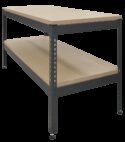Package
AF1125
BENCH-TOP WIND TUNNEL
Open-circuit, bench top subsonic wind tunnel for a wide range of investigations into aerodynamics. Included with the Wind Tunnel are 3 sets of different models and the Basic Lift and Drag Balance.
If you have any questions or you'd like to discuss a product, please call us.
+44 1159 722 611BENCH-TOP WIND TUNNEL
The Bench-Top Wind Tunnel offers a complete system ready for aerodynamic experimentation. A range of models and all necessary instrumentation are included to provide accurate results, suitable for undergraduate study and research projects.
Pitot tubes attach to the working section and connect to a liquid manometer so students can analyse pressure at different positions and calculate air speed. TecQuipment supply a two-component balance with the Wind Tunnel. It uses an electronic force sensor to measure the lift or drag forces on models fitted to the working section. It has a clear digital display giving a direct reading of the measured force value, for real-time data collection.
A bench-mounting metal frame holds all parts of the wind tunnel in one compact unit. Air enters the tunnel through an aerodynamically designed effuser (inlet cone) and honeycomb flow straightener that accelerates the air linearly. It then enters the working section and passes through a grille before moving through a diffuser and then to a variable-speed fan. The grille protects the fan from damage by loose objects. The air leaves the fan, passes up through a silencer unit and then back out to atmosphere.
A controller with an electronic drive allows the user to vary the fan speed (and air velocity) accurately from zero to full speed. The electronic drive keeps the chosen speed constant.
The working section of the tunnel has a square section of removable transparent sides with fixing points to support the wind tunnel models.
Learning outcomes
A wide variety of subsonic aerodynamics experiments, including:
- Flow past bluff and streamlined bodies
- Pressure distribution around a cylinder
- Lift and drag forces











